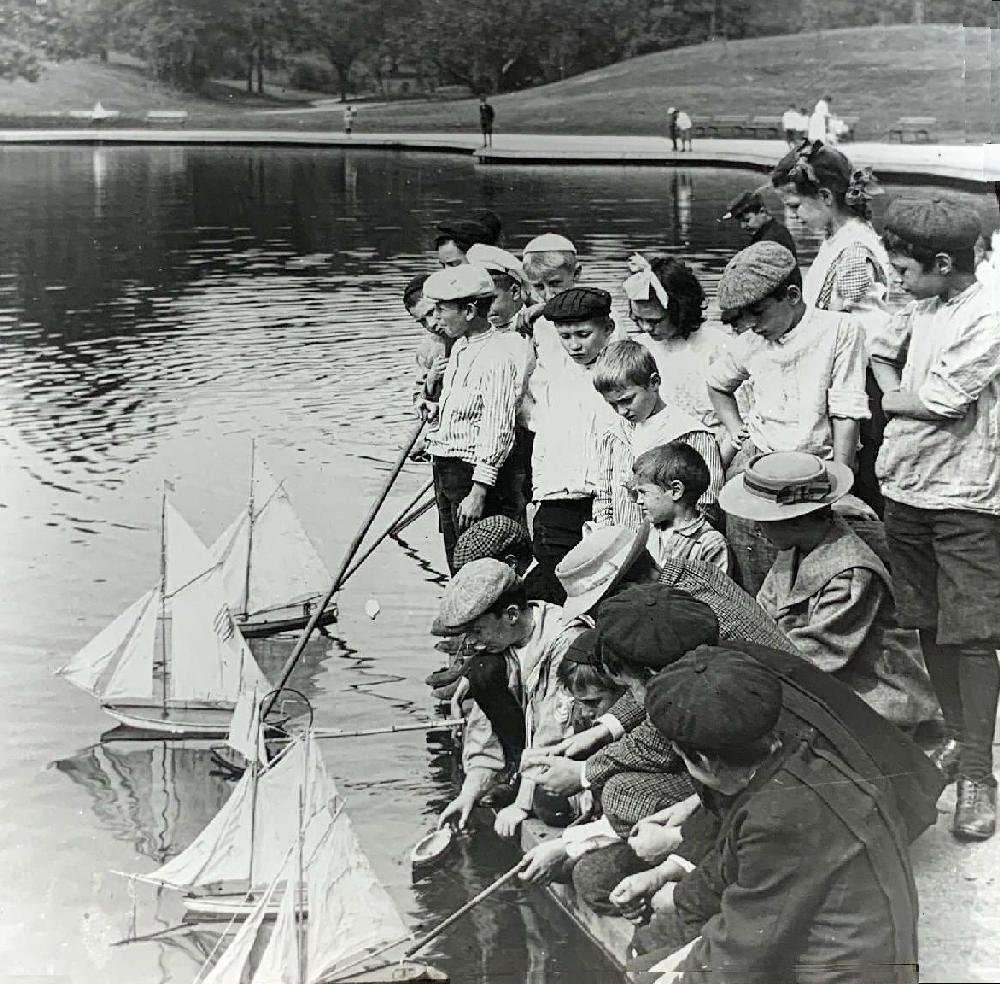
United States Boys' Headwear: 1910s Chronology--Types

Figure 1.--Here we see a bit of a regatta underway. Notice that it wa mostly a boy activity although there are two girl observers. This magic lattern slide is undated, but would have been in the 1910s. We see both hats and caps. The grls have hair bows. Notice how prevalent headwear was. Flat caps were the most popular. We see a few peakled caps. Two boys have flat top hats with wide brims--especially characteristic of the 1910s. We are not sure where this photograoph was taken, perhaps Central Park in New York City.
|
|
The two basic types of boys' headwear were hars and caps in the 1910s. Caps were the most common, bt we sill see many boys wearing hats. Hats were declining in popularity, but we still see quite a number. There were also berets abd beanies, but they were not very common even for younger boys. There were some destinctive hat types, such as turned down brims in the 190s. We see many different cap in the 1900s, but in the 1910s the flat cap was the dominant cap style, commonly worn with knickers. Hats declined in popularity for boys in the 1910s. We see far fewer boys wearing hats than was common in the 19th century. That said we see more hats in the 1900s and 10s than we see subsequently in the 20th century after World War I. The flat cap in particular became very common for boys. We note wide-brimmed sailor hats with the brim turned down. This is a signature style of the 1910s. Younger boys still wearing hats often wore them with the brim or part of it bent up or down. Most boys wore caps in the 1910s, but hats were still common. This actually would be the last decade in which hats werre commonly worn by boys, although caps were more common. The flat cap continued to grow in popularity during the 1910s. Caps in the 1900s were more diverse. We still see other caps in the 1910s, but the flat cap was decidely the most popular style, especially by the mid-1910s. The flat cap is today seen as a rather casual style, but for boys in the 1910s it was worn both as a casual style as well as a more formal style with a suit, although there were some differences from family to family. Some suits even had matching caps. We see boys wearing British-styled peaked caps in the 1900s, but in the 1910s, while the peaked cap
Hats declined in popularity for boys in the 1910s. We see far fewer boys wearing hats than was common in the 19th century. That said we see more hats in the 1900s and 10s than we see subsequently in the 20th century after World War I. The flat cap in particular became very common for boys. We note wide-brimmed sailor hats with the brim turned down. This is a signature style of the 1910s. Younger boys still wearing hats often wore them with the brim or part of it bent up or dowm. Some hats like boaters had stiff brims that could not be folded down, but we see many hadts with brims that could be folded ir bent in various ways. This is adestinctive style that was especially common during the 1910s. Other hats had more flexible brims that could be worn in many different ways. This was largely a style for children from well-to-do families. And hats tended to be worn for more formal occassions such as going to church on Sunday. The American Boy Scouts adopted the broad-brimmed hat used by the British Scouts and most other Scouts around the world. There were no Scout caps in the 1910s as the Cubs had not yet been organized.
Most boys wore caps in the 1910s, but hats were still common. This actually would be the last decade in which hats werre commonly worn by boys, although caps were more common. The flat cap continued to grow in popularity during the 1910s. Caps in the 1900s were more diverse. We still see other caps in the 1910s, but the flat cap was decidely the most popular style, especially by the mid-1910s. The flat cap is today seen as a rather casual style, but for boys in the 1910s it was worn both as a casual style as well as a more formal style with a suit, although there were some differences from family to family. Some suits even had matching caps. We see boys wearing British-styled peaked caps in the 1900s, but in the 1910s, while the peakd cap did not diappear, the flat cap became dominant. Many boys wore flat caps to school. We see other cap styles mostly in the winter. Boys in northern states might wears woodsmen caps. The flat cap could be worn during the winter and many flat caps had flaps that could be pulled down over the ears. We are not sure how common this was. Relatively few images show the ear flaps pulled down, but we sugggest the flaps were more common that suggested by the photographic record. The British-style peaked cap which was quite common in the 1900s declined in popularity. It also began to take on a more upper-class association and became more of a formal style worn with suits.
HBC

Navigate the Boys' Historical Clothing Web Site:
[Return to the Main U.S. headwear 1910s chronology headwear page]
[Return to the Main U.S. headwear 20th chronology hats page]
[Return to the Main U.S. headwear 20th chronology page]
[Return to the Main U.S. headwear page]
[Return to the Main U.S. country garment page]
[Introduction]
[Activities]
[Biographies]
[Chronology]
[Clothing styles]
[Countries]
[Bibliographies]
[Contributions]
[FAQs]
[Glossary]
[Images]
[Links]
[Registration]
[Tools]
[Boys' Clothing Home]
Created: 8:59 AM 11/26/2018
Last updated: 8:59 AM 11/26/2018



